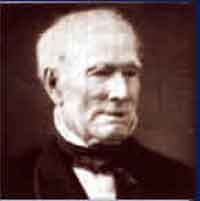|

William Brown
(1777-1857)
(Archivo General de la Nación)
|
Brown,
William
(1777-1857), naval officer and founder of the Argentine navy,
was
born in Foxford, Co. Mayo, on 22 June 1777. In 1786 William
Brown was taken by his father to settle in Pennsylvania, though
some historians argue that he was an illegitimate son of William
Gannon and Mrs. Brown from Sligo. Brown began his naval career
as a cabin boy in merchant ships, and was pressed into service
by the British navy in 1796. During the Napoleonic Wars he was
made a prisoner by the French and sent to Lorient. On being
transferred to Metz he succeeded in escaping disguised in a
French officer's uniform. He was recaptured, however, and then
imprisoned in the fortress of Verdun. From there, in 1809, he
escaped in the company of a British colonel named Clutchwell and
eventually reached Germany, from where he traveled to England.
That year he married in Kent to Eliza Chitty.
Later in 1809 William Brown was engaged in commercial business
with the River Plate, chiefly trading arms and munitions on both
sides of the river. Brown got involved in the War of
Independence when he arrived in Buenos Aires port during the
revolution of 1810 to find it blockaded by Spanish ships. When
his ship was commandeered by the Spanish, he organized an
expedition which captured one of the blockading ships and
brought it in triumph into port. Brown went back to England and
returned to Buenos Aires definitively in 1812 with his wife and
two children. Offered the command of a small fleet by the
Argentine authorities, he defeated the Spanish in Martín García
and broke their blockade of Montevideo in March 1814, allowing
its capture by the patriot army and the effective end the
Spanish threat to the newly independent state.
In 1815 the government sent Brown and his fleet to the Pacific.
He led the forces which in 1816 stormed during three weeks the
Peruvian port of Callao, a Spanish stronghold in South America,
and then went on to capture the fort of Punta de las Piedras at
the mouth of Guayaquil Bay in southern Ecuador. Before finding
his way back to Buenos Aires, Brown was captured by the Spanish
in Ecuador, and then by the British in Barbados, and had to
fight his case in a British court. On return, he faced a
government instigation into his exploits and was retired from
active service in 1819. William Brown was, however, recalled to
service upon the outbreak of war with Brazil in 1825/28, during
which he gained a number of major victories in Montevideo, Pozos,
Juncal, Quilmes and again in Martín García. In 1828 Brown was
appointed governor of Buenos Aires. Later in 1841 he led the
successful campaign against Garibaldi and Admiral John H. Coe.
In 1847 Brown visited his native Foxford accompanied by his
daughter. On his death on 4 March 1857 at Buenos Aires, William
Brown was given a public funeral and buried with full honors in
Recoleta cemetery.
Edmundo
Murray
References
- De Courcy Ireland, John. The Admiral from Mayo: A life of
Almirante William Brown from Foxford. Dublin: Eamonn de
Burca, 1995.
- Geraghty, Michael. "Was Admiral Brown Admiral Someone Else?"
Irish Migration Studies in Latin America, talk at the
British Engineering Association of Buenos Aires, April 6, 2004,
http://www.irishargentine.org (cited May 2004).
- Read, Jan. The New Conquistadors. London: Evans
Brothers Ltd., 1980.
- Ratto, Capt. Héctor R. Historia del Almirante Brown.
Buenos Aires: Instituto de Publicaciones Navales, 1985.
|


